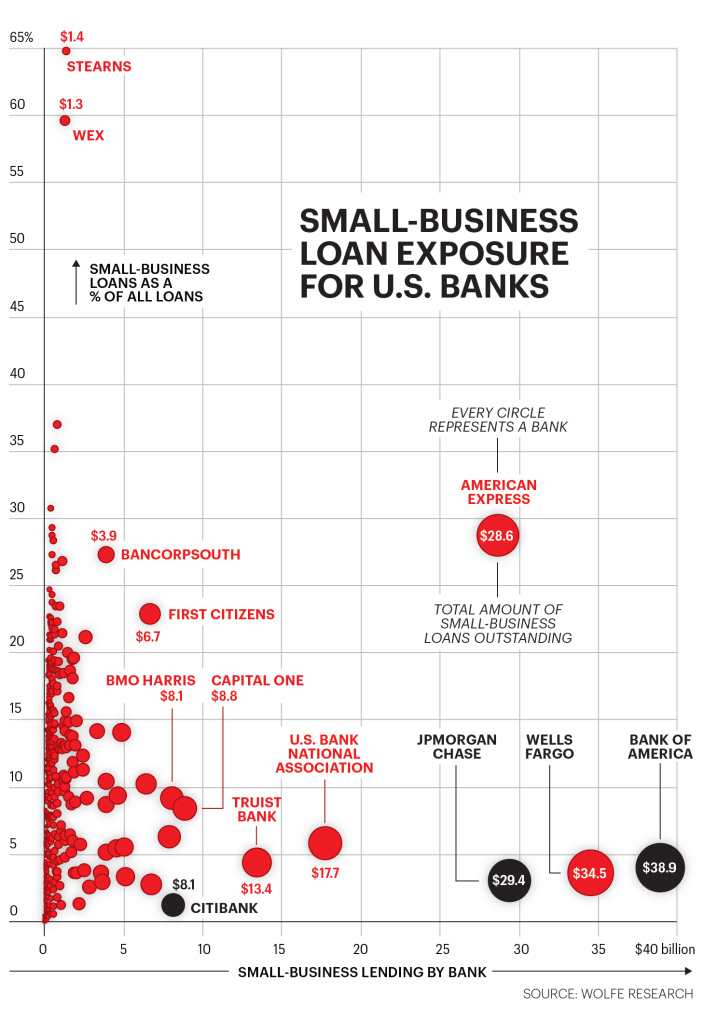近十年内,美国各大银行每年都要接受美联储严格的“压力测试”,评估其应对另一场经济大萧条式危机的能力。评论家们纷纷谴责说,强迫各大银行以承受高达两位数的失业率和8个百分点的GDP降幅为基准修筑巨型战壕——是过度谨慎的做法。不过,你瞧,突然之间,各银行就不得不面对比监管机构的糟糕政策更加糟糕的局面。美国富国银行的分析师迈克·梅奥说:“当政府要求它们增持资本、增加流动资金时,各大银行都又吵又闹地抗议。但正是因为这样的政策,它们如今才能保持这么好的状态。”
考虑到冠状病毒大流行病对华尔街造成的损害,眼下看来,“压力测试”政策确实至关重要。从2020年年初到4月初,KBW银行股指数已下跌了33.6%——比标普500指数多出20个百分点。摩根大通的首席执行官杰米·戴蒙在年度致股东信中预警称,该行今年的收益将“大幅下降”,可能危及其股息。Wolfe Research精品公司和KBW投资银行都曾预测,如果经济衰退延续到2021年,那么美国四大银行——摩根大通、美国银行、花旗集团和富国银行——的利润可能会暴跌60%以上。
这场危机已经迫使各大商业和投资银行进入了收益大幅下降的新周期。不过,与2008年的状况完全不同,即使在最可怕的情况下,它们的利润率应该也能保持为正值。此外,各大银行也即将进入充斥着资本和流动资金的急剧低迷期。华尔街是经济大萧条时期的风暴中心,而如今,放贷方和担保方已经有足够的恢复力可以成为解决方案的一部分——作为向大大小小的企业提供高达4万亿美元紧急资金的渠道,并继续为它们的常规客户(从汽车制造商到美发沙龙)提供信贷。

近十年内,银行业几乎发展到了黄金阶段,在此期间,各银行都积累了大量资金。它们都受益于强大的经济和保守的管理——部分是由美联储决定的,部分是由类似于戴蒙和美国银行的首席执行官布莱恩·莫尼汉等人强制实行的。各大银行通过建立和收购财富管理专营权的方式,进入了能够产生稳定收益的领域。最重要的是,在“压力测试”的推动下,各大银行都积蓄了资本。从2008年年末至2019年,摩根大通的权益资本占其资产负债表的比例上升了51%,美国银行和富国银行的权益资本增加了一倍多,花旗集团的权益资本则增加了两倍多。进入2020年后,各大银行的资本积累已经达到了自1940年以来的最高水平。
对于经济复苏来说,持久力至关重要。大型银行是中小型企业的一大资金来源——此类企业总计雇有近万名员工,并向超过70%的美国工人发放工资。截至2019年年底,四大银行已经向中小型企业发放了8360亿美元的“工商”贷款,占据美国全部银行贷款额的45%。四大银行还为酒店业主和开发商等提供了4220亿美元的金融贷款,相当于美国银行发出的商业房地产贷款总额的28%。
经济停滞之下,中小型企业的现金储备已近枯竭。刺激计划号召各银行向1700万家中小型企业提供由政府担保的贷款。放贷方会通过两条渠道发放援助贷款。一是总额度为3,490亿美元的薪资保障计划(PPP),申请到的贷款最高可达1000万美元,主要面向员工人数不超过500的公司。并且,如果在获得贷款后的8周内,该公司的薪酬水平都未发生改变,其债务就会被免除。对包括四大银行在内的美国各银行来说,薪资保障计划都是件好事,因为这些贷款机构无须承担任何信用风险,且一众银行家在接受采访时均表示,发放贷款(尤其是200万美元以上的贷款)时支付的手续费就能让他们赚上一笔了。
由于大部分贷款很可能都会变成赠款,所以薪资保障计划将帮助申请方在不增加债务负担的情况下渡过经济复苏的难关。此外,经济薄弱的企业在申请成功后,可以加付1%的利息,用新贷款偿还先前的高利率(可能高达4%或5%)贷款,从而增加自己的现金流。简单地说,薪资保障计划向小企业提供赠款或低利息的担保融资,降低了银行的信贷风险,也降低了未来的不良贷款率。
第二种渠道对银行来说就没有那么容易了。主街贷款计划(Main Street Lending Program)将向雇员达到1万人的中型企业提供贷款。对四大银行来说,此类目下的贷款总额将数倍于小型企业的贷款总额。由美联储提供现金,财政部为95%的融资提供担保;各银行将只保留5%的账面金额。根据美联储的计划,主街贷款计划发放高达6000亿美元的贷款。但这些贷款与薪资保障计划提供的救济可完全是两码事。借款方必须将钱还给政府。如果出现违约,那么美国政府则可以通过没收资产或强制宣告破产来保护纳税人的利益。
对于各银行来说,在帮助借款方撑过更艰难的几个月后,主街贷款计划可能会有所收益。但如果经济衰退持续到今年年底或再往后,许多陷入困境、过度负债的公司可能会需要获得更多的紧急资金援助。各银行将因此陷入两难的境地,也必然会面临监管机构要求发放贷款的巨大压力。到那时,各银行就将需要动用过去十年间积累起来的所有财力了。
本文另一版本登载于《财富》杂志2020年5月刊,标题为《这一次,各银行已经做好了应对危机的准备》。(财富中文网)
译者:殷圆圆
近十年内,美国各大银行每年都要接受美联储严格的“压力测试”,评估其应对另一场经济大萧条式危机的能力。评论家们纷纷谴责说,强迫各大银行以承受高达两位数的失业率和8个百分点的GDP降幅为基准修筑巨型战壕——是过度谨慎的做法。不过,你瞧,突然之间,各银行就不得不面对比监管机构的糟糕政策更加糟糕的局面。美国富国银行的分析师迈克·梅奥说:“当政府要求它们增持资本、增加流动资金时,各大银行都又吵又闹地抗议。但正是因为这样的政策,它们如今才能保持这么好的状态。”
考虑到冠状病毒大流行病对华尔街造成的损害,眼下看来,“压力测试”政策确实至关重要。从2020年年初到4月初,KBW银行股指数已下跌了33.6%——比标普500指数多出20个百分点。摩根大通的首席执行官杰米·戴蒙在年度致股东信中预警称,该行今年的收益将“大幅下降”,可能危及其股息。Wolfe Research精品公司和KBW投资银行都曾预测,如果经济衰退延续到2021年,那么美国四大银行——摩根大通、美国银行、花旗集团和富国银行——的利润可能会暴跌60%以上。
这场危机已经迫使各大商业和投资银行进入了收益大幅下降的新周期。不过,与2008年的状况完全不同,即使在最可怕的情况下,它们的利润率应该也能保持为正值。此外,各大银行也即将进入充斥着资本和流动资金的急剧低迷期。华尔街是经济大萧条时期的风暴中心,而如今,放贷方和担保方已经有足够的恢复力可以成为解决方案的一部分——作为向大大小小的企业提供高达4万亿美元紧急资金的渠道,并继续为它们的常规客户(从汽车制造商到美发沙龙)提供信贷。
近十年内,银行业几乎发展到了黄金阶段,在此期间,各银行都积累了大量资金。它们都受益于强大的经济和保守的管理——部分是由美联储决定的,部分是由类似于戴蒙和美国银行的首席执行官布莱恩·莫尼汉等人强制实行的。各大银行通过建立和收购财富管理专营权的方式,进入了能够产生稳定收益的领域。最重要的是,在“压力测试”的推动下,各大银行都积蓄了资本。从2008年年末至2019年,摩根大通的权益资本占其资产负债表的比例上升了51%,美国银行和富国银行的权益资本增加了一倍多,花旗集团的权益资本则增加了两倍多。进入2020年后,各大银行的资本积累已经达到了自1940年以来的最高水平。
对于经济复苏来说,持久力至关重要。大型银行是中小型企业的一大资金来源——此类企业总计雇有近万名员工,并向超过70%的美国工人发放工资。截至2019年年底,四大银行已经向中小型企业发放了8360亿美元的“工商”贷款,占据美国全部银行贷款额的45%。四大银行还为酒店业主和开发商等提供了4220亿美元的金融贷款,相当于美国银行发出的商业房地产贷款总额的28%。
经济停滞之下,中小型企业的现金储备已近枯竭。刺激计划号召各银行向1700万家中小型企业提供由政府担保的贷款。放贷方会通过两条渠道发放援助贷款。一是总额度为3,490亿美元的薪资保障计划(PPP),申请到的贷款最高可达1000万美元,主要面向员工人数不超过500的公司。并且,如果在获得贷款后的8周内,该公司的薪酬水平都未发生改变,其债务就会被免除。对包括四大银行在内的美国各银行来说,薪资保障计划都是件好事,因为这些贷款机构无须承担任何信用风险,且一众银行家在接受采访时均表示,发放贷款(尤其是200万美元以上的贷款)时支付的手续费就能让他们赚上一笔了。
由于大部分贷款很可能都会变成赠款,所以薪资保障计划将帮助申请方在不增加债务负担的情况下渡过经济复苏的难关。此外,经济薄弱的企业在申请成功后,可以加付1%的利息,用新贷款偿还先前的高利率(可能高达4%或5%)贷款,从而增加自己的现金流。简单地说,薪资保障计划向小企业提供赠款或低利息的担保融资,降低了银行的信贷风险,也降低了未来的不良贷款率。
第二种渠道对银行来说就没有那么容易了。主街贷款计划(Main Street Lending Program)将向雇员达到1万人的中型企业提供贷款。对四大银行来说,此类目下的贷款总额将数倍于小型企业的贷款总额。由美联储提供现金,财政部为95%的融资提供担保;各银行将只保留5%的账面金额。根据美联储的计划,主街贷款计划发放高达6000亿美元的贷款。但这些贷款与薪资保障计划提供的救济可完全是两码事。借款方必须将钱还给政府。如果出现违约,那么美国政府则可以通过没收资产或强制宣告破产来保护纳税人的利益。
对于各银行来说,在帮助借款方撑过更艰难的几个月后,主街贷款计划可能会有所收益。但如果经济衰退持续到今年年底或再往后,许多陷入困境、过度负债的公司可能会需要获得更多的紧急资金援助。各银行将因此陷入两难的境地,也必然会面临监管机构要求发放贷款的巨大压力。到那时,各银行就将需要动用过去十年间积累起来的所有财力了。
本文另一版本登载于《财富》杂志2020年5月刊,标题为《这一次,各银行已经做好了应对危机的准备》。(财富中文网)
译者:殷圆圆
For the past decade, the big U.S. banks have endured arduous annual Federal Reserve “stress tests” gauging their strength to weather another Great Recession–like crisis. Critics groused that forcing financial titans to build gigantic war chests—modeled to withstand a replay of double-digit joblessness and an eight-point drop in GDP—was unnecessarily cautious. But, lo and behold, banks are suddenly confronted with a scenario even worse than the regulators’ worst case. “The banks were kicking and screaming while the government made them build capital and liquidity,” says Mike Mayo, an analyst with Wells Fargo. “But that’s why they’re in such good shape today.”
Indeed, the stress-test policy appears absolutely crucial now, given the damage that the coronavirus pandemic is unleashing on Wall Street. From the start of 2020 through early April, the KBW banking index dropped 33.6%—20 points more than the S&P 500. JPMorgan Chase CEO Jamie Dimon warned in his annual letter that the bank’s earnings would “be down meaningfully” this year, conceivably endangering its dividend. And both boutique firm Wolfe Research and investment bank KBW forecast that profits for the Big Four banks—JPMorgan, Bank of America, Citigroup, and Wells Fargo—could crater more than 60% if a recession extends into 2021.
The crisis has pushed the major commercial and investment banks into a new cycle of much lower earnings. But in a reversal from 2008, their profits should remain positive even in the direst scenario. Plus, they’re entering a sharp downturn flush with capital and liquidity. Whereas Wall Street was the problem in the Great Recession, today the lenders and underwriters have the resiliency to be part of the solution—as conduits for channeling as much as $4 trillion in emergency funding to businesses large and small, and continuing to extend credit to their regular customers, from automakers to hairdressing salons.
The banks built up their finances in what has been a near-golden period for the industry over the past 10 years. They benefited from a combination of a strong economy and conservative management—partly dictated by the Fed, and partly imposed by such leaders as Dimon and BofA CEO Brian Moynihan. Banks diversified into areas that generated steady earnings, notably by building and buying wealth management franchises. Most of all, pushed by the stress tests, the banks shored up their capital. From late 2008 to 2019, equity capital as a share of the balance sheet rose 51% at JPMorgan, more than doubled at BofA and Wells, and tripled at Citi. Entering 2020, the big banks boasted their strongest capital levels since 1940.
That staying power is crucial to seeding a recovery. The major banks are a giant source of funding to small- and medium-size businesses, or SMEs—typically enterprises that employ up to 10,000 and issue paychecks for over 70% of U.S. workers. At year-end 2019, the Big Four held $836 billion in “commercial and industrial” or C&I loans to SMEs. That was 45% of the total for all U.S. banks. The Big Four also provide the likes of hotel owners and developers $422 billion in financing, equal to 28% of all commercial real estate lending provided by America’s banks.
The economy’s shutdown is starving SMEs for cash. The stimulus plan marshals the banks to originate and service government-guaranteed loans to as many as 17 million of these enterprises. The aid designed to flow through the lenders comes via two main vehicles. The first is the $349 billion Paycheck Protection Program (PPP). It makes loans of up to $10 million mostly to companies with 500 or fewer employees. And if a company’s payroll stays the same for eight weeks after it gets a loan, the debt is forgiven. The PPP is a good thing for America’s banks, including the Big Four. The lenders take no credit risk, and, according to interviews with bankers, the fees paid to originate the loans make them profitable, especially for amounts up to $2 million.
Since most of the loans are likely to become grants, the PPP will help bridge their clients through to the recovery without adding to their debt load. Plus, fragile businesses can use the new loans, charging 1% interest, to pay the interest on existing, at-risk borrowings at, say, 4% or 5%—lifting their cash flow. Put simply, the PPP lowers the banks’ credit risk by providing either grants or cheaper, guaranteed financing to small businesses, and lowering the number of bad loans going forward.
****
The second program is less of a slam dunk for banks. The Main Street Lending Program will extend loans to medium-size businesses employing up to 10,000 people. For the Big Four, that category is several times the size of their small-business books. The Fed is providing the cash and the Treasury is guaranteeing 95% of the financings; the banks will keep just 5% on their books. Under the Fed’s plan, up to $600 billion in Main Street loans will be offered. But these loans are a different species from the relief offered by the PPP. The borrowers have to repay the government. If they default, the U.S. can protect taxpayers by seizing assets or forcing them into bankruptcy.
For the banks, the Main Street program could pay off by supporting their clients through a few more difficult months. But if a recession stretches into late this year or beyond, many struggling, overleveraged companies might need to seek additional emergency funding. That would create a quandary for the banks, who will certainly face intense pressure from regulators to make the loans. In that scenario, the banks will need to draw on every bit of the financial strength they built up over the past decade.
A version of this article appears in the May 2020 issue of Fortune with the headline “This time, the banks were ready for a crisis.”






